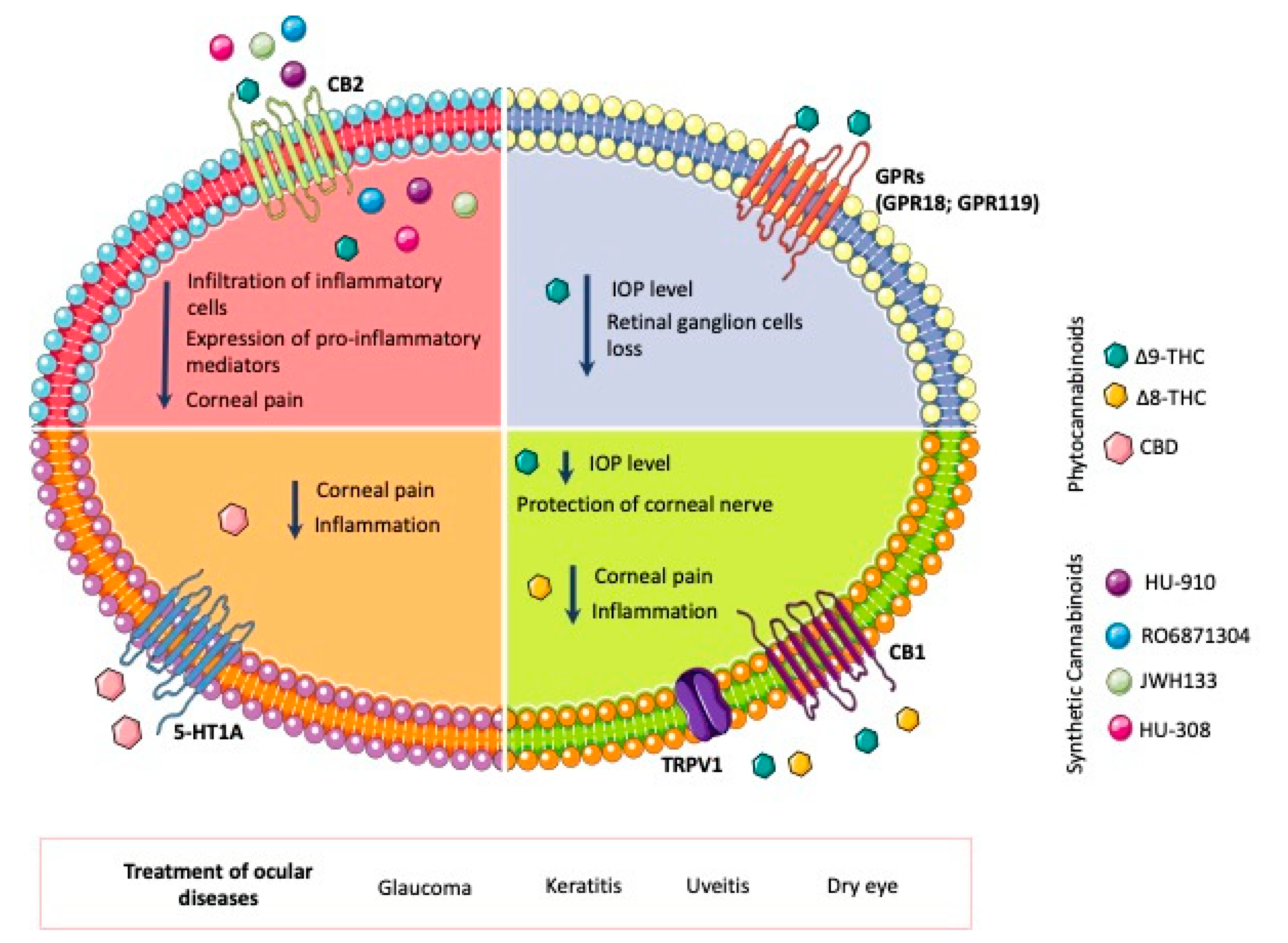Cannabinoid-Based Ocular Therapies and Formulations

The interest in the pharmacological applications of cannabinoids is largely increasing in a wide range of medical areas. Recently, research on its potential role in eye conditions, many of which are chronic and/or disabling and in need of new alternative treatments, has intensified. However, due to cannabinoids’ unfavorable physicochemical properties and adverse systemic effects, along with ocular biological barriers to local drug administration, drug delivery systems are needed. Hence, this review focused on the following: (i) identifying eye disease conditions potentially subject to treatment with cannabinoids and their pharmacological role, with emphasis on glaucoma, uveitis, diabetic retinopathy, keratitis and the prevention of Pseudomonas aeruginosa infections; (ii) reviewing the physicochemical properties of formulations that must be controlled and/or optimized for successful ocular administration; (iii) analyzing works evaluating cannabinoid-based formulations for ocular administration, with emphasis on results and limitations; and (iv) identifying alternative cannabinoid-based formulations that could potentially be useful for ocular administration strategies. Finally, an overview of the current advances and limitations in the field, the technological challenges to overcome and the prospective further developments, is provided.
Introduction
Marijuana, cannabis, hemp and weed are commonly used terms for Cannabis sativa, which has been used since ancient times (2700 a.c.) [1]. Due to its narcotic and psychotropic effects, it was consumed mainly as a recreational drug in early years, which undermined its consideration as a potential therapeutic [2,3]. However, its numerous pharmaceutical properties prompted further research on cannabis as a medicinal product, which proved to be prolific [2,4]. As a result, in the last years, different institutions have reviewed the pharmacological properties of cannabis, which has led to its decriminalization and availability for therapeutic use [5,6,7]. Some of the diseases for which cannabinoids have demonstrated therapeutic activity include neurological disorders, muscle spasticity, multiple sclerosis symptoms, spinal cord lesions and epilepsy, to mention a few [8]. Still, nowadays, the most well documented therapeutic benefit of cannabinoids, and therefore their wider prescription, is in the prophylaxis and management of nausea and sickness related to antineoplastic chemotherapeutics [9]. Nonetheless, several synthetic cannabinoids have entered the international pharmaceutical market, such as nabilone and dronabinol [10]. Some examples of FDA-approved products are Epidiolex® (cannabidiol (CBD)) for the treatment of refractory epilepsy-associated seizures, Marinol® and Syndros® (Dronabinol, synthetic Δ9-THC), both for chemotherapy-induced nausea and vomiting and anorexia in patients with acquired immune deficiency syndrome (AIDS).
Among the increasing number of identified pharmacological properties of cannabinoids, a potential use in ocular diseases is also being considered. Even though many legislations specifically within the EU do not currently provide for the use of cannabis for the treatment of eye diseases [11,12], the current climate of renewed interest in cannabis medical use and legalization promotes research in this area. Many of these conditions are chronic and even incapacitating and currently do not come with a convenient or sufficiently effective treatment, hence the need for alternative therapies [13]. The therapeutic potential of cannabinoids in ocular pathologies is mainly due to their role in the endocannabinoid system. This physiological system is constituted by several receptors, mainly cannabinoid receptors CB1 and CB2 (Figure 1), and their natural endogenous ligands, such as anandamide (N-arachidonoylethanolamine, AEA) and 2-arachidonoylglycerol (2-AG), which are synthesized on demand by different enzymatic pathways [14] (Figure 2). In addition, non-cannabinoid receptors such as transient receptor potential vanilloid 1 (TRPV1), G-protein-coupled receptor 18 (GPR18), GPR55, GPR119 and peroxisome proliferator-activated receptors (PPARs), GABA receptors and ion channels are also activated by endocannabinoids (Figure 1) [15]. Thus, their use is being considered for an increasing number of ocular syndromes [16].
Download the full article as PDF here Cannabinoid-Based Ocular Therapies and Formulations
or read it here
Saraiva, S.M.; Martín-Banderas, L.; Durán-Lobato, M. Cannabinoid-Based Ocular Therapies and Formulations. Pharmaceutics 2023, 15, 1077. https://doi.org/10.3390/pharmaceutics15041077
Read more on “The Role of Excipients in CBD Products” here


